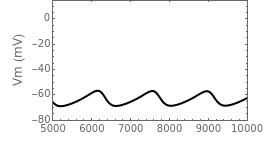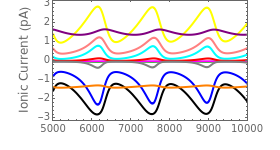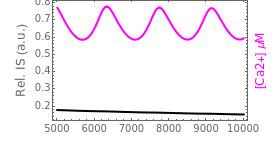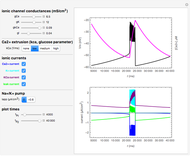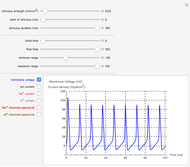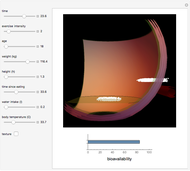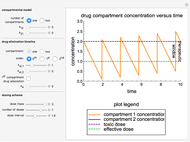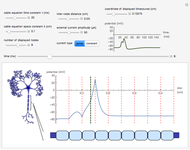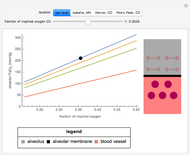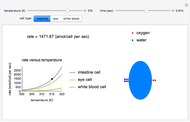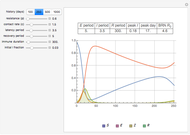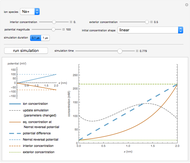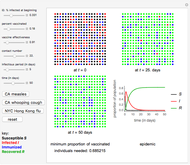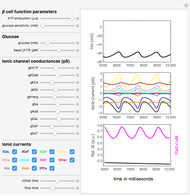Model of Electrical Activity in Human Pancreatic Beta Cells

Requires a Wolfram Notebook System
Interact on desktop, mobile and cloud with the free Wolfram Player or other Wolfram Language products.
This Demonstration shows how a simulated human  cell behaves in terms of electrical activity and insulin secretion at different glucose levels. It is also possible to simulate the effect of the blockage of the ionic channels by changing their conductances.
cell behaves in terms of electrical activity and insulin secretion at different glucose levels. It is also possible to simulate the effect of the blockage of the ionic channels by changing their conductances.
Contributed by: Gerardo J. Felix-Martinez (September 2015)
Based on a model by: L. Fridlyand et al., extended by G. J. Félix-Martínez and J. R. Godínez-Fernández.
Open content licensed under CC BY-NC-SA
Snapshots
Details
This Demonstration is an implementation of the mathematical model described in [1] on the effects of impaired  cell functioning. The model of the electrical activity of the human
cell functioning. The model of the electrical activity of the human  cell of Fridlyand et al. [2] was extended by including the relationship between glucose and ATP production showed by Li et al. [3].
cell of Fridlyand et al. [2] was extended by including the relationship between glucose and ATP production showed by Li et al. [3].
In terms of the parameters shown,  cell dysfunction is simulated by: (1) inhibiting ATP production; or (2) reducing glucose sensitivity (by increasing the value of the corresponding parameter). This Demonstration considers only the non-oscillatory cases described in the references.
cell dysfunction is simulated by: (1) inhibiting ATP production; or (2) reducing glucose sensitivity (by increasing the value of the corresponding parameter). This Demonstration considers only the non-oscillatory cases described in the references.
Ionic currents included in the model are:
Type L, T, and P/Q-type Ca2+ current (ICaL, ICaT, ICaP), voltage-gated Na+ current (INa), Na+ background current (INab), delayed rectifier K+ current (IKDr), ERG K+ current (IKhe), ATP-sensitive K+ channel (IKATP), Ca2+ high voltage K+ current (IKCaB), and Ca2+-activated K+ current (IKCa).
The magnitude of the ionic currents depends on the value of the corresponding maximal conductance (gX): gCaL, gCaT, gCaP, gNa, gNaB, gKDr, gKHerg, gKATP, gKCaB, and gKCa.
References
[1] G. J. Félix-Martínez, J. Azpiroz-Leehan, R. Ávila-Pozos, and J. R. Godínez Fernández, “Effects of Impaired ATP Production and Glucose Sensitivity on Human  -cell Function: A Simulation Study,” La Revista Mexicana de Ingeniería Biomédica, 35(2), 2014 pp.157–170. www.redalyc.org/pdf/619/61933945006.pdf.
-cell Function: A Simulation Study,” La Revista Mexicana de Ingeniería Biomédica, 35(2), 2014 pp.157–170. www.redalyc.org/pdf/619/61933945006.pdf.
[2] L. E. Fridlyand, D. A. Jacobson, and L. H. Philipson, "Ion Channels and Regulation of Insulin Secretion in Human  -cells: a Computational Systems Analysis," Islets, 5(1), 2013 pp. 1–15. doi:10.4161/isl.24166.
-cells: a Computational Systems Analysis," Islets, 5(1), 2013 pp. 1–15. doi:10.4161/isl.24166.
[3] J. Li, H. Y. Shuai, E. Gylfe, and A. Tengholm, "Oscillations of Sub-membrane ATP in Glucose-Stimulated Beta Cells Depend on Negative Feedback from Ca2+," Diabetologia, 56(7), 2013 pp. 1577–1586. doi:10.1007/s00125-013-2894-0.
Permanent Citation
